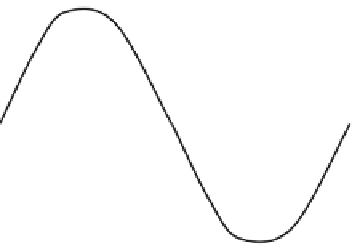Environmental Engineering Reference
In-Depth Information
+
0
90°
180°
270°
360°
-
FIGURE 7.2
Sinusoidal wave showing wavelength and amplitude.
peaks (or troughs) to pass a given fixed point is period
T
. The
frequency
(ν) of the
wave describes the number of peak-to-peak (or trough-to-trough) oscillations of the
wave surface per second, as seen by a fixed observer, and is the reciprocal of the
period; that is, ν = 1/
T
.
If a wave is traveling at velocity
v
past a given fixed point, it will travel a distance
equal to its wavelength (λ) in a time equal to the wave period
T
(i.e.,
v
= λ/
T
). The
power (
P
) of an idealized ocean wave is approximately equal to the square of height
H
multiplied by wave period
T
. The exact expression is
gHT
2
2
P
=
32
where
P
is in units of watts per meter and
g
is the acceleration due to gravity (9.81
m/s
2
) (Phillips, 1977).
Deep Water Waves
For deep water waves, the velocity of a long ocean wave can be shown to be propor-
tional to the period (if the depth of water is greater than about half of wavelength λ)
as follows:
gT
=
2π
v
The velocity in meters per second is approximately 1.5 times the wave period in
seconds. It is interesting to note that in the deep ocean long waves travel faster than
shorter waves. Moreover, if the above relationships hold, we can find the deep water
wavelength (λ) for any given wave period:
=
gT
2
2
λ
π







